
Japan is an island country in East Asia. It is situated in the northwest Pacific Ocean and is bordered on the west by the Sea of Japan, extending from the Sea of Okhotsk in the north toward the East China Sea, Philippine Sea, and Taiwan in the south. Japan is a part of the Ring of Fire, and spans an archipelago of 14,125 islands, with the five main islands being Hokkaido, Honshu, Shikoku, Kyushu, and Okinawa. Tokyo is the nation's capital and largest city, followed by Yokohama, Osaka, Nagoya, Sapporo, Fukuoka, Kobe, and Kyoto.

The economy of Japan is a highly developed/advanced social market economy, often referred to as an East Asian model. It is the third-largest in the world by nominal GDP and the fourth-largest by purchasing power parity (PPP). It is the world's second-largest developed economy. Japan is a member of both the G7 and G20. According to the IMF, the country's per capita GDP (PPP) was at $51,809 (2023). Due to a volatile currency exchange rate, Japan's GDP as measured in dollars fluctuates sharply. The Japanese economy is forecast by the Quarterly Tankan survey of business sentiment conducted by the Bank of Japan. The Nikkei 225 presents the monthly report of top blue chip equities on the Japan Exchange Group, which is the world's fifth-largest stock exchange by market capitalisation. In 2018, Japan was the world's fourth-largest importer and the fourth-largest exporter. It has the world's second-largest foreign-exchange reserves, worth $1.4 trillion. It ranks 5th on the Global Competitiveness Report. It ranks first in the world in the Economic Complexity Index. Japan is also the world's fourth-largest consumer market.
A keiretsu is a set of companies with interlocking business relationships and shareholdings that have dominated the Japanese economy since the second half of the 20th century. In the legal sense, it is a type of informal business group that are loosely organized alliances within the social world of Japan's business community. It rose up to replace the zaibatsu system that was dissolved in the Occupation of Japan following the Second World War, and, though their influence has shrunk since the late 20th century—they continue to be important forces in Japan's economy in the early 21st century.

The yen is the official currency of Japan. It is the third-most traded currency in the foreign exchange market, after the United States dollar (US$) and the euro. It is also widely used as a third reserve currency after the US dollar and the euro.
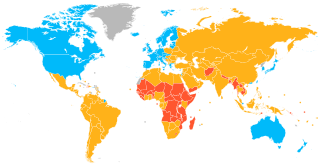
A developed country, orhigh-income country, is a sovereign state that has a high quality of life, developed economy, and advanced technological infrastructure relative to other less industrialized nations. Most commonly, the criteria for evaluating the degree of economic development are the gross domestic product (GDP), gross national product (GNP), the per capita income, level of industrialization, amount of widespread infrastructure and general standard of living. Which criteria are to be used and which countries can be classified as being developed are subjects of debate. Different definitions of developed countries are provided by the International Monetary Fund and the World Bank; moreover, HDI ranking is used to reflect the composite index of life expectancy, education, and income per capita. Another commonly used measure of a developed country is the threshold of GDP (PPP) per capita of at least USD$22,000. In 2023, 37 countries fit all four criteria, while an additional 16 countries fit three out of four.

The Bank of Japan is the central bank of Japan. The bank is often called Nichigin (日銀) for short. It has its headquarters in Chūō, Tokyo.

The Kantō region is a geographical region of Honshu, the largest island of Japan. In a common definition, the region includes the Greater Tokyo Area and encompasses seven prefectures: Gunma, Tochigi, Ibaraki, Saitama, Tokyo, Chiba, and Kanagawa. Slightly more than 45 percent of the land area within its boundaries is the Kantō Plain. The rest consists of the hills and mountains that form land borders with other regions of Japan.
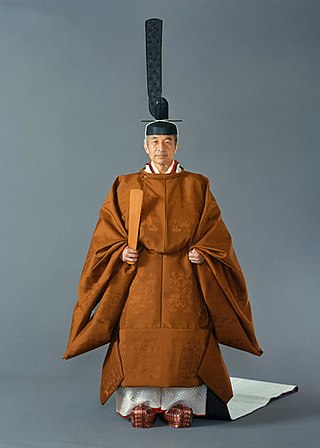
The Heisei era was the period of Japanese history corresponding to the reign of Emperor Emeritus Akihito from 8 January 1989 until his abdication on 30 April 2019. The Heisei era started on 8 January 1989, the day after the death of the Emperor Hirohito, when his son, Akihito, acceded to the throne as the 125th Emperor. In accordance with Japanese customs, Hirohito was posthumously renamed "Emperor Shōwa" on 31 January 1989.

The 1997 Asian financial crisis was a period of financial crisis that gripped much of East and Southeast Asia during the late 1990s. The crisis began in Thailand in July 1997 before spreading to several other countries with a ripple effect, raising fears of a worldwide economic meltdown due to financial contagion. However, the recovery in 1998–1999 was rapid, and worries of a meltdown quickly subsided.

The economic history of Japan is most studied for the spectacular social and economic growth in the 1800s after the Meiji Restoration. It became the first non-Western great power, and expanded steadily until its defeat in the Second World War. When Japan recovered from devastation, it became the world's second largest economy behind the United States, and from 2010 behind China as well. Scholars have evaluated the nation's unique economic position during the Cold War, with exports going to both U.S.- and Soviet-aligned powers, and have taken keen interest in the situation of the post-Cold War period of the Japanese "lost decades".
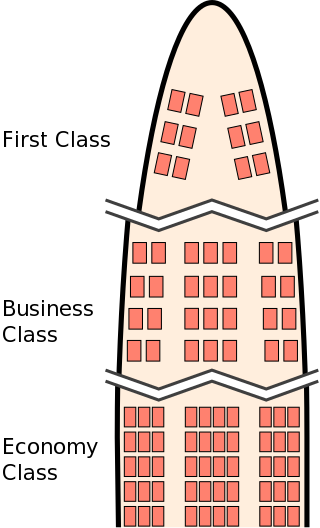
A travel class is a quality of accommodation on public transport. The accommodation could be a seat or a cabin for example. Higher travel classes are designed to be more comfortable and are typically more expensive.

The economy of Asia comprises about 4.7 billion people living in 50 different nations. Asia is the fastest growing economic region, as well as the largest continental economy by both GDP Nominal and PPP in the world. Moreover, Asia is the site of some of the world's longest modern economic booms, starting from the Japanese economic miracle (1950–1990), Miracle on the Han River (1961–1996) in South Korea, economic boom (1978–2013) in China, Tiger Cub Economies (1990–2020) in ASEAN, and economic boom in India (1991–present).
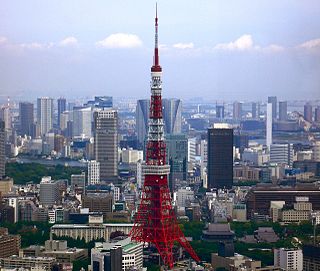
The Japanese asset price bubble was an economic bubble in Japan from 1986 to 1991 in which real estate and stock market prices were greatly inflated. In early 1992, this price bubble burst and Japan's economy stagnated. The bubble was characterized by rapid acceleration of asset prices and overheated economic activity, as well as an uncontrolled money supply and credit expansion. More specifically, over-confidence and speculation regarding asset and stock prices were closely associated with excessive monetary easing policy at the time. Through the creation of economic policies that cultivated the marketability of assets, eased the access to credit, and encouraged speculation, the Japanese government started a prolonged and exacerbated Japanese asset price bubble.

The Japanese economic miracle refers to Japan's record period of economic growth between the post-World War II era and the end of the Cold War. During the economic boom, Japan rapidly became the world's second-largest economy. By the 1990s, Japan's population demographics had begun to stagnate, and the workforce was no longer expanding as quickly as it had in the previous decades despite per-worker productivity remaining high.
Japanization, Japanisation or Japanification is the process by which Japanese culture dominates, assimilates, or influences other cultures. According to The American Heritage Dictionary of the English Language, "To japanize" means "To make or become Japanese in form, idiom, style, or character".

The economy of East Asia comprises 1.6 billion people living in six different countries and regions. The region includes several of the world's largest and most prosperous economies: Japan, South Korea, Mainland China, Taiwan, Hong Kong, and Macau. It is home to some of the most economically dynamic places in the world, being the site of some of the world's most extended modern economic booms, including the Japanese economic miracle (1950–1990), Miracle on the Han River (1961–1996) in South Korea, the Taiwan miracle in Taiwan (1960–1996) and the current economic boom (1978–2015) in Mainland China.
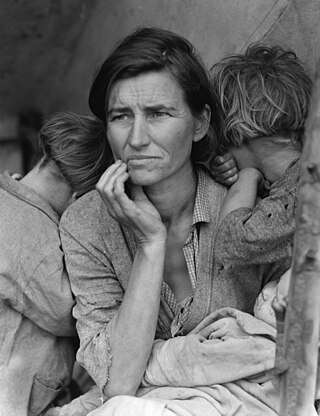
The Great Depression (1929–1939) was an economic shock that impacted most countries across the world. It was a period of economic depression that became evident after a major fall in stock prices in the United States. The economic contagion began around September and led to the Wall Street stock market crash of October 24. It was the longest, deepest, and most widespread depression of the 20th century.

The Lost Decades was a period of economic stagnation in Japan caused by the asset price bubble's collapse in late 1991. The term originally referred to the 1990s, but the 2000s and the 2010s have been included by commentators as the phenomenon continued.
The East Asian model pioneered by Japan, is a plan for economic growth whereby the government invests in certain sectors of the economy in order to stimulate the growth of specific industries in the private sector. It generally refers to the model of development pursued in East Asian economies such as Japan, South Korea and Taiwan. It has also been used by some to describe the contemporary economic system in Mainland China after Deng Xiaoping's economic reforms during the late 1970s and the current economic system of Vietnam after its Đổi Mới policy was implemented in 1986.
This is a list of tables showing the historical timeline of the exchange rate for the Indian rupee (INR) against the special drawing rights unit (SDR), United States dollar (USD), pound sterling (GBP), Deutsche mark (DM), euro (EUR) and Japanese yen (JPY).














